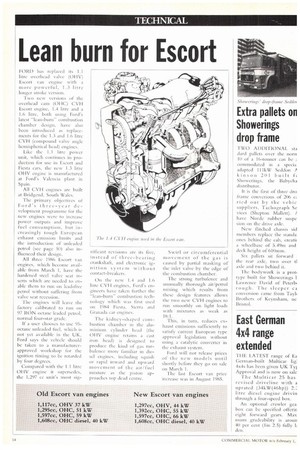Lean burn for Escort
Page 14

If you've noticed an error in this article please click here to report it so we can fix it.
FORD has replaced its 1.1 litre overhead valve (OHV) Escort van engine with a more powerful, 1.3 litre longer stroke version.
Two new versions of the overhead cam (011C) CVH Escort engine, 1.4 litre and a 1.6 litre, both using Ford's latest "lean-burncombustion chamber design, have also been introduced as replacements for the 1.3 and 1.6 litre CVH (compound valve angle hemispherical head) engines.
Like the 1.1 litre power unit, which continues in production for use in Escort and Fiesta cars, the new 1.3 litre OHV engine is manufactured at Ford's Valencia plant in Spain.
All CVH engines are built at Bridgend, South Wales.
The primary objectives of Ford's three-year development programme for the new engines were to increase power outputs and improve fuel consumption, but increasingly tough European exhaust emission limits and the introduction of unleaded petrol (see page 50) also in111/enced their design.
All three 1986 Escort van engines, which become available from March 1. have the hardened steel valve seat inserts which are needed to enable them to run on lead-free petrol without suffering from valve seat recession.
The engines will leave the factory calibrated to run on 97 RON octane leaded petrol, normal four-star grade.
If a user chooses to use 95octane unleaded tUel, which is not yet available in the UK, Ford says the vehicle should be taken to a manufacturerapproved workshop for the ignition timing to be retarded by four degrees.
Compared with the 1.1 litre 011V engine it supersedes, the 1.297 cc unit's roost sig
nificant revisions are its five, instead of three-bearing crankshaft, and electronic ig
nition system without contact-breakers.
On the new 1.4 and 1.6 litre CVI I engines, Ford's engineers have taken further the 'lean-burncombustion technology which was first used on 1984 Fiesta, Sierra and Granada car engines.
The kidney-shaped combustion chamber in the aluminium cylinder head (the 01-IV engine retains a cast iron head) is designed to produce the kind of gas turbulence more familiar in diesel engines, including squish or rapid inward and upward movement of the air/fuel mixture as the piston approaches top dead centre. Swirl or circumferential movement of the gas is caused by partial masking of the inlet valve by the edge of the combustion chamber.
The strong turbulence and unusually thorough air/petrol mixing which results from these design features allows the two new CVH engines to run smoothly on light loads with mixtures as weak as 18:1.
This, in turn, reduces exhaust emissions sufficiently to satisfy current European type approval legislation without using a catalytic converter in the exhaust system.
Ford will not release prices of the new models until shortly before they go on sale on March 1.
The last Escort van price increase was in August 1985.




















































